Are your Facebook lead generation ads providing less-than-stellar results? Do you need fresh ideas for creating and optimizing audiences so you can collect more leads without increasing your budget?
In this article, you'll learn how to build seven highly targeted audiences for Facebook lead gen ads and get tips for incorporating this ad type into your sales funnel.
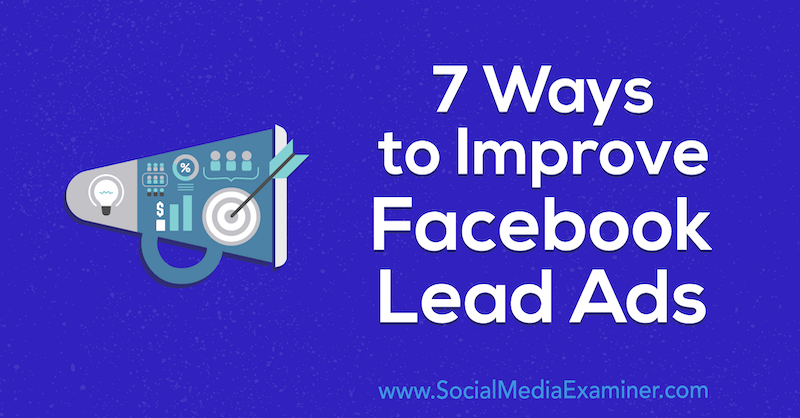
Why You Should Create a Lead Gen Campaign With Facebook Ads
This Facebook ad campaign type uses the Lead Generation objective. It's designed to help your business collect leads and get permission to market directly to prospects. In exchange, you might offer something that leads genuinely want, such as cutting-edge research or a useful tool.
For example, this lead gen ad from ZoomInfo offers an eBook for marketers seeking advanced growth strategies:
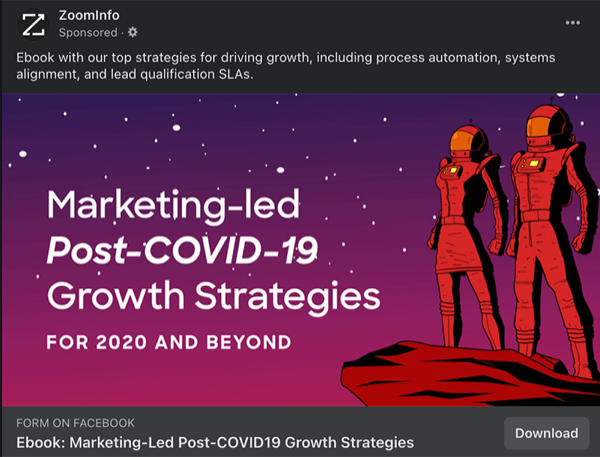
After collecting prospects' contact information, your team can nurture these leads and guide them toward a conversion. The ZoomInfo lead form makes it clear that prospects will receive both the eBook and other related marketing materials.
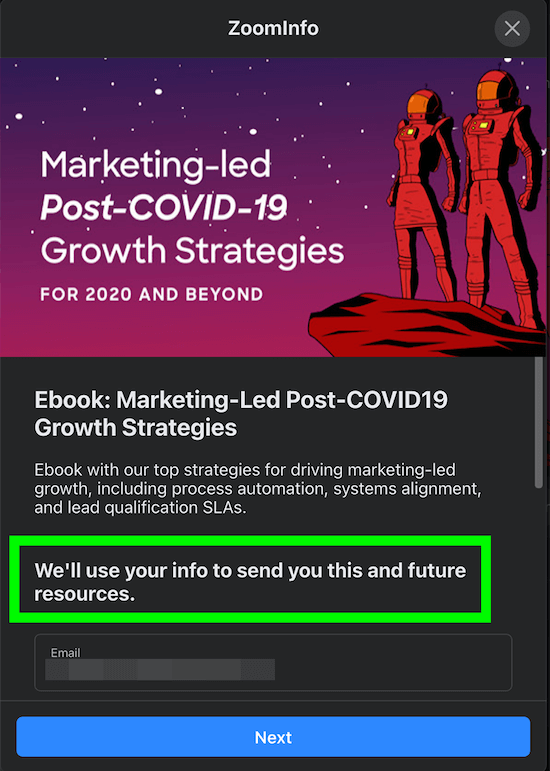
In most cases, a conversion is your ultimate marketing goal. Depending on your business, conversion might refer to anything from signing up for a free trial to purchasing a lifetime subscription. However, lead gen campaigns aren't geared toward driving conversions—at least not directly.
So why would you want to invest in this type of ad? Lead generation ads offer some seriously helpful benefits such as:
- Providing value to an engaged audience. As a marketer, you're eager to build credibility because you want prospects to trust your brand. Lead gen ads let you achieve this by offering an exchange of equal value. Prospects entrust you with their contact information, and in return, they get the asset your team created as a solution to their problem.
- Remarketing to interested groups. This type of ad generally works best when you retarget people who know your brand and are ready to consider the solutions your business offers. Because these users are already partway to a conversion, persuading them to exchange their contact info is easier and more cost-effective than it would be when marketing to less-aware users.
- Opening new avenues to connect with prospects. Lead gen ads grant you permission to contact prospects directly. That means you can start nurturing leads via a series of emails or phone calls. Because you'll be communicating directly with leads, you can provide personalized responses that speak to their needs.
- Learning about potential customers. Lead gen campaigns usually require prospects to fill out a contact form to get the offer. In addition to asking for essential info like their names, email addresses, and phone numbers, you can ask them questions. For example, you can ask leads to identify with one of a list of customer groups or prompt them to tell you how your business can help.
Octane AI's lead gen ad offers a lengthy 400-page eCommerce marketing playbook. In exchange for such a valuable asset, the lead form includes in-depth questions that help the brand better understand prospects' needs. Octane AI can then leverage this data to nurture leads.

Which Awareness Levels Should a Lead Gen Campaign Target?
Lead gen campaigns have a consideration-focused objective. That means they're engineered for prospects who are somewhere in the middle of their journey toward becoming a customer.
Here's how lead gen campaigns fit into the buyer's journey:
Get World-Class Marketing Training — All Year Long!
Are you facing doubt, uncertainty, or overwhelm? The Social Media Marketing Society can help.
Each month, you’ll receive training from trusted marketing experts, covering everything from AI to organic social marketing. When you join, you’ll also get immediate access to:
- A library of 100+ marketing trainings
- A community of like-minded marketers
- Monthly online community meetups
- Relevant news and trends updates
- Awareness: This group has just entered your sales funnel and started to learn what your business is all about. They're beginning to research solutions so they're not quite ready to respond to lead gen ads yet. After you run awareness-focused campaigns, you can use the data to build remarketing ads for lead generation.
- Consideration: These users have a good understanding of the problem they're trying to solve. They're actively seeking a solution and they're familiar with your brand. A lead gen ad is the perfect fit for this middle-of-the-funnel group.
- Conversion: This audience group is ready to make a decision or a purchase. They're the most aware of all of your prospects and they've made it to the bottom of your sales funnel. After running lead gen ads, you can remarket to that audience to develop conversion-focused ads.
Are you curious about how best to target audiences at the consideration stage of the buyer's journey? Use one of these seven middle-of-the-funnel audiences for your next lead generation campaign.
#1: Facebook Page- or Instagram Account-Based Custom Audience
Does your brand already have a strong presence on Facebook or Instagram? Whether you have a large following or a highly engaged audience, your profile's data is ideal for generating leads.
Start by creating a custom audience and then select either Instagram Account or Facebook Page as the seed.

Then select the specific kind of interaction you want to target. Your options include:
- People who currently like your page: All of your followers excluding those who have unliked your page.
- Everyone who engaged with or visited your page: Anyone who's ever clicked on your brand's profile page or interacted with any organic post or paid ad.
- Anyone who has had a specific interaction with your page: People who have taken a certain action related to your brand such as sending a message or saving a post.
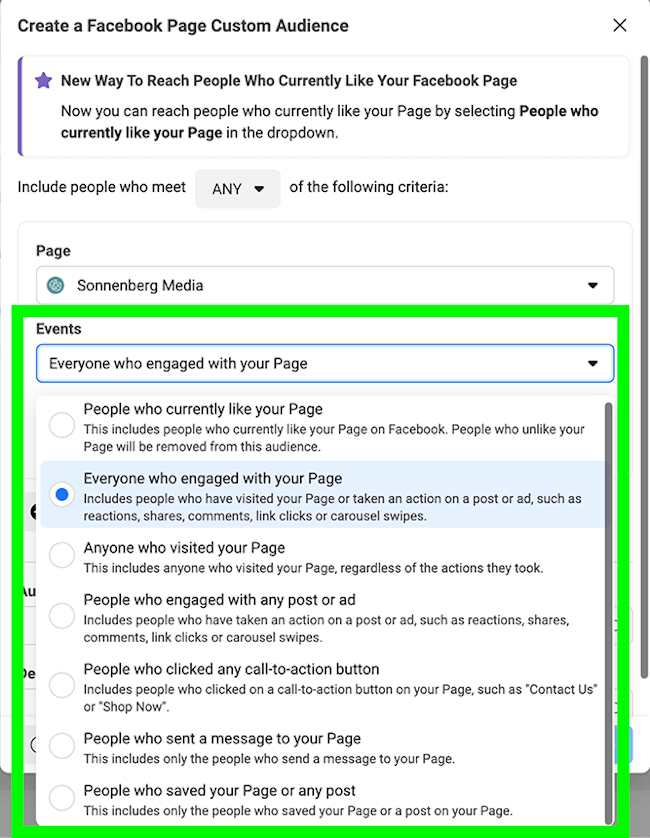
By default, this type of custom audience includes people who interacted with your account within the past 365 days. To ensure you're reaching the right people, you can change this setting to reflect almost any time frame. For example, you can target people who engaged only in the past 30 days. Focusing on such a recent time frame can help you find people who are actively shopping for a solution.
Are you having trouble deciding which to choose—or do you want to select more than one targeting option? With Facebook ad campaigns, you can get much more specific. Check out the last section for a walkthrough.
#2: Website-Based Custom Audience
If you use the Facebook pixel to collect data on website visitor behavior, you can design audiences around visitors to certain pages or people who have completed specific events. Creating a website-based audience is a great choice if you've published website content for people at various stages of the buyer's journey.

Choose the Website option for your audience and select the Facebook pixel you want to use as a data source. By default, Facebook targets All Website Visitors, which likely includes a mix of people at various points in the buyer's journey.
To target visitors at the consideration stage, choose People Who Visited Specific Web Pages. Then enter the URLs of the pages you want to focus on. For your lead gen audience sources, you might type a service page URL or paste the link to a blog post comparing your business to a competitor.
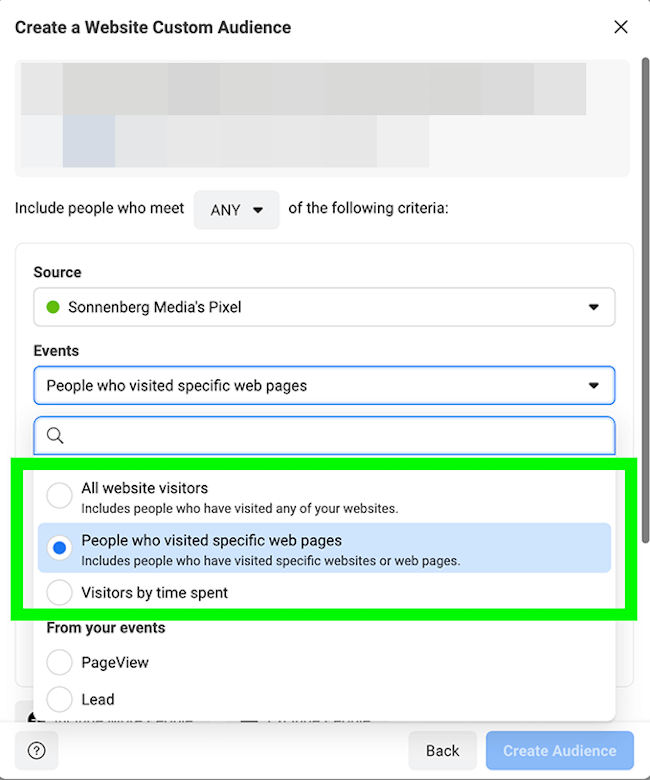
Alternatively, you can use any Facebook pixel events you've set up to seed your audience. Be sure to review the retention period before finalizing your audience. Facebook defaults to 30 days but you may want to make it longer or shorter depending on the typical sales cycle for your audience.

#3: Video Views-Based Custom Audience
Does your company produce video content with different stages of the buyer's journey in mind? You can use this video data to identify prospects at the consideration stage and then retarget them with a lead gen ad.


Discover Proven Marketing Strategies and Tips
Want to go even deeper with your marketing? Check out the Social Media Marketing Podcast! Publishing weekly since 2012, the Social Media Marketing Podcast helps you navigate the constantly changing marketing jungle, with expert interviews from marketing pros.
But don’t let the name fool you. This show is about a lot more than just social media marketing. With over 600 episodes and millions of downloads each year, this show has been a trusted source for marketers for well over a decade.
Pick Video from the list of custom audience sources and then choose the level of engagement you want to target. Because lead gen ads are great for people who are relatively far along in the buyer's journey, consider checking People Who Either Completed or Viewed at Least 15 Seconds of Your Video (ThruPlay) or a similarly high level of engagement. Then select the previously published video content—either organic or paid—that you want to target.

By leveraging this type of audience, you can make sure you're targeting a highly aware, solution-focused group of people who have already consumed your brand's targeted content. That can help keep your team's costs in check while optimizing your results.
#4: Instant Experience–Based Custom Audience
Have your past Instant Experience ads gotten great results? You can use this data to seed your lead gen campaigns. Choose Instant Experience from the options and then select the media you want to build from. If all of your past Instant Experiences have targeted the same audience, you can simply pick them all.

By default, this audience includes everyone who's opened your Instant Experience. Do you want to target people who demonstrated a higher level of interest in your original ad? Choose People Who Clicked Any Links in This Instant Experience instead.
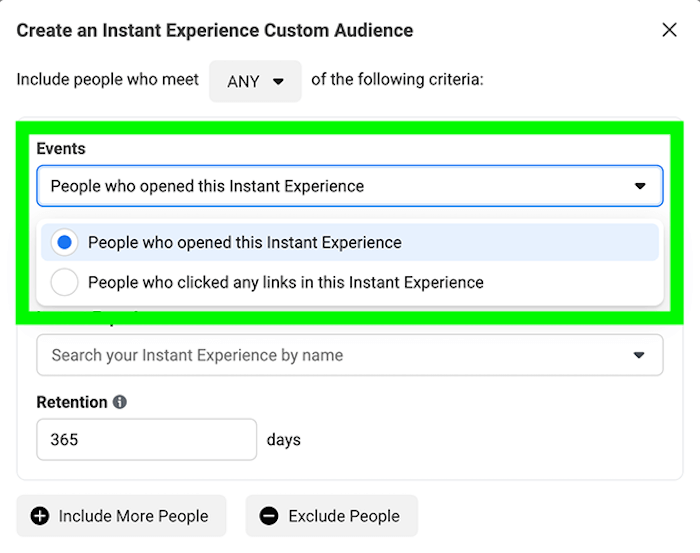
#5: Virtual Event-Based Custom Audience
Has your team hosted a targeted Facebook Live or promoted a consideration-focused virtual event via Facebook? Your event data can seed a remarketing audience for highly engaged prospects. For example, you could remarket to people who attended a Facebook Live about your new product line or a webinar about your company's latest personalized program.
Start by selecting Events as the seed audience.
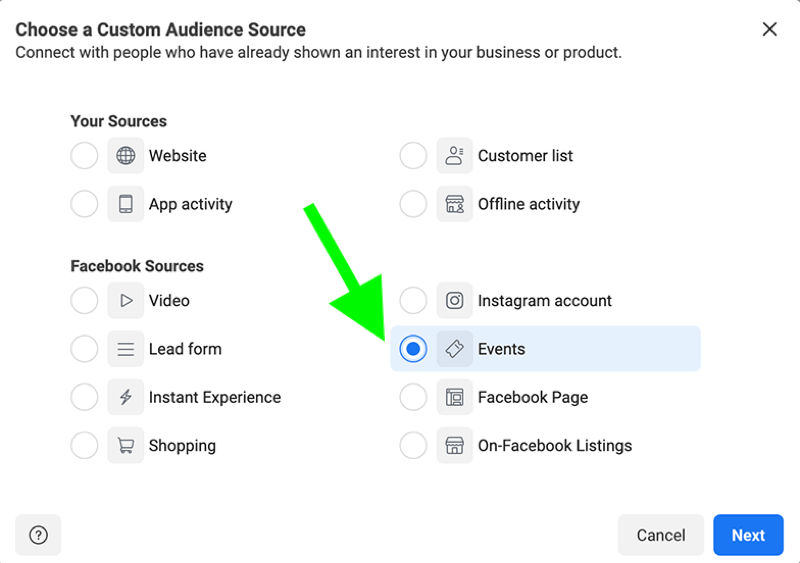
Then decide which level of engagement you want to target. To cover the most engaged group of users, pick People Who Have Responded Going or People Who Have Purchased Tickets.
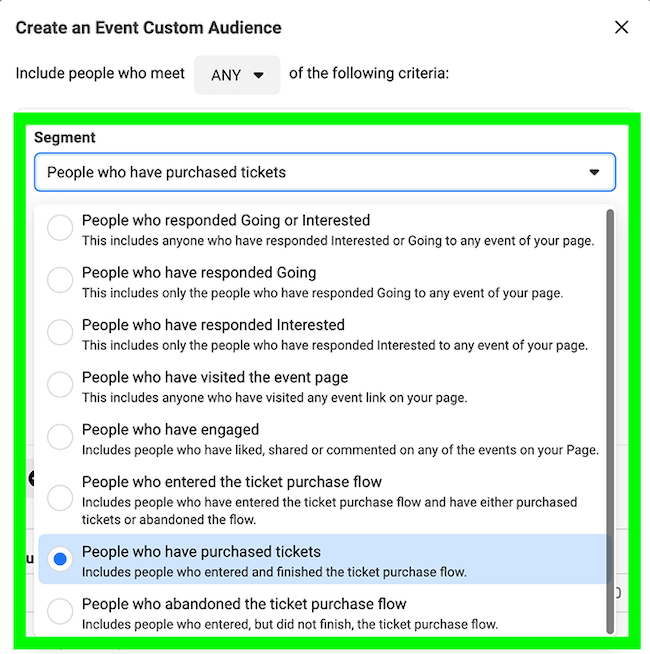
#6: Customer List-Based Custom Audience
If your email list already includes prospects at the consideration stage of the buyer's journey, you might be wondering why you'd want to target them with a lead gen ad. After all, you already have their contact info.
Fair point but this targeting option is more powerful than you might think. In your ad's lead gen form, you can ask prospects to self-identify as interested in a certain product, service, or solution.
If your lead gen form requests sufficient permissions, you can add these prospects to targeted drip campaigns. Then you can nurture their interest automatically and guide them toward the solution they're seeking.
To use your email subscribers as a seed audience, start by segmenting interested contacts. Then select Customer List from the Facebook Ads audience options.

Then follow the prompts. You can import your customer list directly from a connected marketing platform or you can use the Facebook ads template to format and upload your list.

#7: Lookalike Audience
After testing out one or more of the audiences above, you might find that you're getting fantastic results from your lead gen campaign. You'd really like to start driving more of the same results at a similar cost, but there's a problem—you're already reaching your target audience at the optimal frequency. If you keep focusing on the same audience, you're concerned about causing ad fatigue or driving up costs.
You could prioritize awareness-focused ads, which would increase the number of people entering your sales funnel. Eventually, prospects would arrive at the consideration stage, where they'd be primed for your lead gen ads.
Alternatively, you can create a lookalike audience, which includes Facebook users who are similar to your source audiences. You can use any custom audience as a seed for your lookalike audience and it doesn't necessarily have to be one of the options above. In fact, you could use a website purchase event or a list of high-value customers as the source to start advertising to people with similar buying patterns as your best clients.

After choosing your source, decide on the size. The smaller the percentage, the closer the lookalike audience resembles the source. Consider testing out a 1% lookalike audience to start because a less similar group of people might not respond optimally to a conversion-focused lead gen ad.
Keep in mind you can add more targeting parameters to your lookalike audience during the lead gen ad creation process. See below to learn how to layer audiences or add demographic targeting.
Tips for Optimizing Lead Gen Audiences
Running lead gen ads isn't always particularly budget-friendly. To keep your cost per lead as low as possible, take additional steps to optimize your audience and ensure you aren't wasting your budget on the wrong people.
Target Multiple Facebook Ads Audiences
During the Facebook campaign creation process, you can add multiple audiences. Select all of the custom and lookalike audiences you want to target and add them to a single ad set or design several ad sets to run simultaneously.
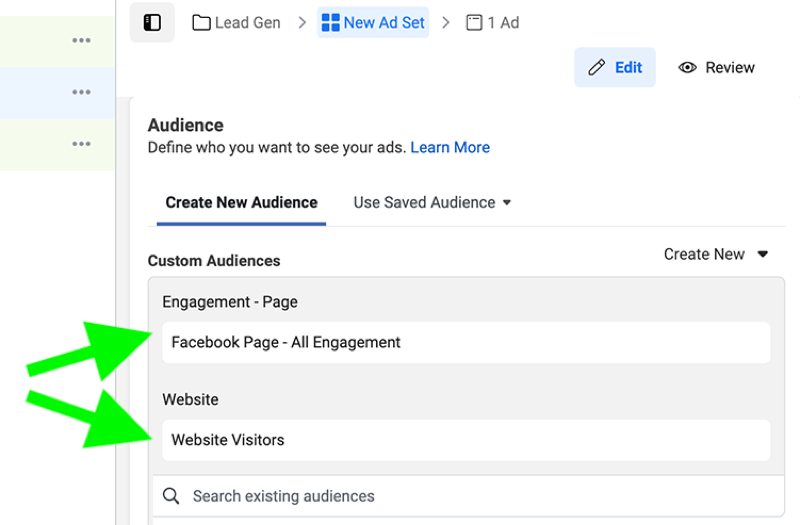
Expand Audience Targeting
You also have the option for Facebook to use its own algorithm to expand your targeting parameters. When creating a campaign, check the Detailed Targeting Expansion box if you want Facebook to handle this process automatically and optimize your results at the same time.

Narrow Facebook Ads Audiences
If you want to make your audience more specific rather than more general, you have a couple of options. First, you can change the logic rule from Any to All when building an audience. Making this adjustment ensures that you'll only reach users who meet every single one of the parameters you set (rather than only one).

Then click the Further Narrow button and select additional criteria for your audience. Continue to narrow your targeting until you reach the exact audience you want to see your lead gen ad.
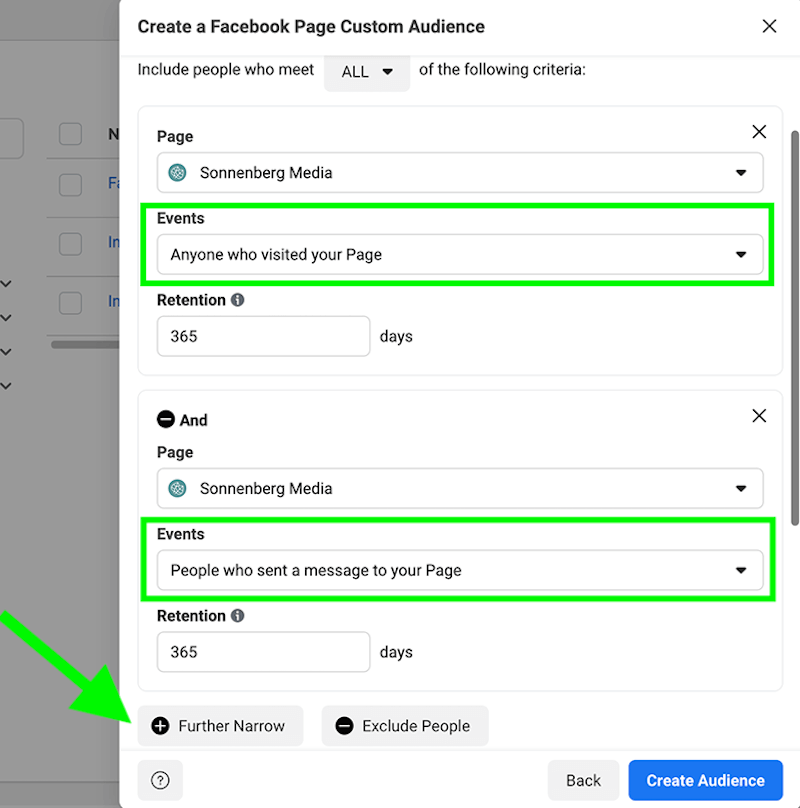
Alternatively, you can layer on targeting parameters when creating your lead gen ad campaign. Choose one or more custom or lookalike audiences and then scroll down to add demographic-, behavior-, or interest-based targeting.

Exclude Audiences From Facebook Ads Targeting
You can also narrow your audience by excluding certain groups of users. Click the Exclude People button and select the group you want to remove from the targeted audience.

Has your team already followed up with prospects who privately messaged your business? You can avoid retargeting these users by opting to exclude people who sent a message to your page.
Conclusion
If you're not getting great results from your Facebook lead generation ads, it may be time to incorporate some new audiences into your campaigns. These seven highly targeted audiences can give a boost to your lead gen campaigns and help you better reach prospects at the consideration stage of the buyer's journey.
Get More Advice on Facebook Ads
- Choose the right Facebook and Instagram campaign objective to achieve your business goal.
- Test Facebook ads without blowing your ad spend.
- Find a Facebook ads strategy that works for your business.
Attention Agency Owners, Brand Marketers, and Consultants

Introducing the Marketing Agency Show–our newest podcast designed to explore the struggles of agency marketers.
Join show host and agency owner, Brooke Sellas, as she interviews agency marketers and digs deep into their biggest challenges. Explore topics like navigating rough economic times, leveraging AI, service diversification, client acquisition, and much more.
Just pull up your favorite podcast app, search for Marketing Agency Show and start listening. Or click the button below for more information.

